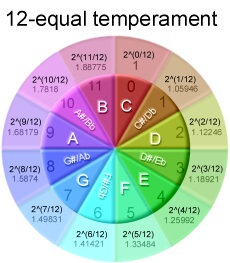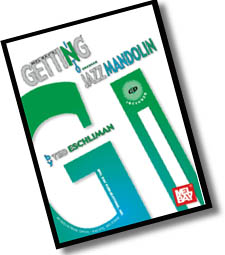« March 2010 |
Main
| May 2010 »
 April 29, 2010 | Moving Forward; Melodic Progression
April 29, 2010 | Moving Forward; Melodic Progression
There are two different perceptions of the "direction" in music, horizontal and vertical. Music can be melody, it can be chords, and usually a combination of both. When one is expressed, the other is often implied; in the case of chord melody playing, a stream of chords, the highest note is perceived aurally as a melody. When you listen to a melody, there is always some degree of harmonic implication. Both are subject to interpretation and context, but a good musician will always take this into account, whether consciously or intuitively.
We've mentioned the concept of "Gravity" notes in past articles (see links below). Within a major scale, you have note are part of the chord, notes that pass to notes that are in the chord, and a third very important function, the notes that propel harmonically to either the notes in the key of the tonal center or the upcoming tonal center in the song.

This is easiest to understand in the context of a major scale when we listen to the pull of the 7 to 1, the 4 to 3, the 6 to 5, and the 2 to 1. Arguably, the first two (7 to 1, 4 to 3) are the strongest and most compelling. The other two can be somewhat tamped, especially when we add the extended members to 7th chords, G9, Eb13, etc.
Why is this important? If you aren't conscious of it, at least intuitively, your improvising can be very bland. Knowing which notes lead, and which notes land can make your solos exponentially more intentional and focused. Simply put, the audience will think you know what you are doing. The solo is less happenstance, more expressive.
This is a big problem for the folk/bluegrass musician who relies heavily on pentatonic scales. Even though the meat of the chord is in the scale, the tension notes of 4 and 7 are absent. In more progressive jazz chord vocabularies, the sound comes off as blather. We won't go into detail here, but the jazz musicians famous for using pentatonic aren't playing ones based on the roots, rather on some of the upper extensions of the chord (see Jazzed Pentatonics).
Back to the major scale, we've integrated the "pulls" into our FFcP exercises (the last two measures of the patterns), and provided a more concentrated exercise to develop this called "Guides & Gravity." Playing through these in all keys will help your fingers get used to their place on the fretboard, and over time, your ear gets better acclimated to the sound.
Have fun! Print exercise: Guides & Gravity.
Further:
4 and 7. The Committal Notes.
Critical Decisions in Improvising: 'Gravity' Notes.
Three Four Pull: Foregoing the Fourth Finger Frack.
Enhanced Pentatonics: What Goes Up Must Come Down.
Posted by Ted at 9:09 AM
 April 22, 2010 | Frets and temperament
April 22, 2010 | Frets and temperament
 Have you ever been scowled at by an orchestral musician for using an electronic tuner? If so, there's a reason that has nothing to do with the ear, but with tradition and the theories of acoustics. The study of equal temperament is much more intriguing than one might suspect, with literal centuries of debate over how to determine exactly "on pitch" is. Have you ever been scowled at by an orchestral musician for using an electronic tuner? If so, there's a reason that has nothing to do with the ear, but with tradition and the theories of acoustics. The study of equal temperament is much more intriguing than one might suspect, with literal centuries of debate over how to determine exactly "on pitch" is.
There's a fascinating article by Slate author Jan Swafford you'll want to read, "The Wolf at Our Heels," about the eternal struggle to play in tune. You'll want to take some time to read this, as it goes into the details of the theory, and more interesting, the social struggles that accompany the "mathematics" of music, and as is all to common, the relativistic aesthetic struggles of right and wrong. Musically.
In essence, the way our scale is laid out linearly is not in perfect compatibility with the vertical (chords), especially when you start migrating tonal centers. For example, a when Perfect 5th of an A and an E is sounded, the same A when used as the 5th of D is mathematically off. Not much, but it's still off though not detected by most ears. However, when you start migrating around the Circle of Fifths, let alone modulate tonal centers in a Broadway song, the variation can be a aurally detectable problem.
Tuning is relative, and in the case of a violin, trombone, or voice, pitch can be instantly adjusted for perfect and exact intonation. You don't have this adjustability in fretted instruments, or keyboard based like piano or xylophone. The only solution is compromise, and the most commonly accepted practice is what's called Equal Temperament.

From the article: "One of those tunings was already known to the ancients: equal temperament. Here the poison is distributed equally through the system: The distance between each interval is mathematically the same, so each interval is equally in, and slightly out of, tune. Nothing is perfect; nothing is terrible. So now it's all fixed, yes? The laughter of the gods has been stilled, right? Are you kidding? You fools: The gods never lose."
Why should this matter? When an orchestra gathers, you have instruments that can adjust playing along with those who can't. Compromise is still a necessity, although slow, exposed sections of instruments may very well be adapted. If you play with a fiddle, cut them some slack when they are tuning their instruments; they are fighting an entirely different intonation battle than those with frets.
Meantime (pun intended), don't throw away your tuner...
Read article: The Wolf at Our Heels
Posted by Ted at 8:49 AM
 April 15, 2010 | Literary Mission
April 15, 2010 | Literary Mission
From our promotional materials on "Getting Into Jazz Mandolin:"
What makes this book different from any other mandolin book?
Though its exercises offer generous benefit to any mandolinist desiring better finger technique and fretboard familiarity, its focus is on the more complex harmonic vocabulary of jazz, but in a slow, non-threatening tack. It's comprehensive, but not cloyingly detailed, bogged down with esoteric trivia. It allows guidance, but also opens doors to nurturing further player self-discovery. It develops playing strength and discipline, but in a fun and entertaining manner.
 A foundational principle of writing is to create a work intentional and specific to a reader. It's a big temptation (and distraction frankly,) for artists and musicians to write for themselves, often at the expense of commercial success. If the literature is to be effective however, the author needs to have the person buying the book in mind from the start of the first page, the outline, and the conclusion. The calculated approach to GiJM had always been to take an advanced beginning player who already knew some basic folk material, knew the names of the notes on the fretboard (or could at least figure them out), and had the desire to take on more complicated music and improvisation. A foundational principle of writing is to create a work intentional and specific to a reader. It's a big temptation (and distraction frankly,) for artists and musicians to write for themselves, often at the expense of commercial success. If the literature is to be effective however, the author needs to have the person buying the book in mind from the start of the first page, the outline, and the conclusion. The calculated approach to GiJM had always been to take an advanced beginning player who already knew some basic folk material, knew the names of the notes on the fretboard (or could at least figure them out), and had the desire to take on more complicated music and improvisation.
We took what we call a Fingers/Ears/Brain approach to the project. Some of the closed fingering concepts were new to many who were still anchored on the open strings on the mandolin, and the first goal was to make fretboard familiarity foundational on finger patterns (1st, 2nd, 3rd, & 4th FFcP), rather than GDAE. Once this is established, the world is your oyster as far as melodic movability. Through practicing the fingers, several months of adaptation would co-produce an aural familiarity. Many readers write in after a few months hearing "notes that just seem to come out of nowhere now" in improvisation. From there, it's possible to start naming those notes and put them in a harmonic context. In other words, the brain comes last.
Language is learned this way. A toddler learns just enough basic words to get fed and played with, and the grammar and syntax comes long after those words. It isn't until middle school, the higher concepts of composition comes into play, by then all the words and basic rules have become intuitive.
We try to have a little fun in the book. Hard core theory is sneaked in, but not until later, long after some of the basic physical elements are internalized. We hope midst the guerrilla cerebral concepts the whole road is laden with interesting personal detours; ultimately, the self-discovery will make you not only a better jazz musician, but a more adaptive musician all around.
Enjoy: Getting Into Jazz Mandolin
Further:
Webtracks Audio Support
Fingers, Ears, Brain.
Paths to fretboard mastery
FFcP
"Math, eggs, and mandolins; higher level understanding
Posted by Ted at 9:15 AM
 April 8, 2010 | More on sustain
April 8, 2010 | More on sustain
We started this last week in our Tips article "The Virtues of Sustain," the concept of the components in achieving great sustain on the mandolin. Everybody understands the notion of starting the sound (picking), and that eventually the sound dies a natural death, or decay. Really, it's more dimensional than that, and a good fretted string musician needs to understand and mentally distinguish the difference between decay and release in creating rich, robust tone.
 Visualize the Attack, Sustain, Decay, & Release of each note at slower tempos, known as the ASDR. After the invariable speed of the Attack, you fight the natural decay of the strings tone by keeping the pressure as close to the next Attack as possible. Strike, HOOOLLLLD, (quick shift), Strike next note, HOOOLLLLD, (quick shift), etc. This is easier when the next note is only putting the finger down on a higher fret. Visualize the Attack, Sustain, Decay, & Release of each note at slower tempos, known as the ASDR. After the invariable speed of the Attack, you fight the natural decay of the strings tone by keeping the pressure as close to the next Attack as possible. Strike, HOOOLLLLD, (quick shift), Strike next note, HOOOLLLLD, (quick shift), etc. This is easier when the next note is only putting the finger down on a higher fret.
This pressure is what minimizes the harsh division between sustain and decay in this picture. Mandolin virtuoso, David Grisman refers to this as "squeezing golf balls," and if you're an aural student of his playing, especially his slower tempo ballads, you hear just how strong his technique is. Note, we aren't talking about playing with tension, just a firm grip on the string with attention to the length of its vibration.
Two big challenges to consider: 1.) crossing strings, and 2.) going lower, when you "lengthen" the string (higher fret to lower fret). That momentary release of pressure produces a gap in the tone, descending the fretboard or moving from string to string. The key is to make your movements quickly, whether a whole position shift or just the next finger.
Keep this in mind as you practice slow tempo scales, modes, and arpeggios, and it will pay off big time in your regular playing!
Further:
Blowing through the phrase
Using the picking hand to start Good Tone.
Three Four Pull: Foregoing the Fourth Finger Frack.
What the Pros say about Good Tone.
The Virtues of Sustain
Posted by Ted at 12:35 PM
 April 1, 2010 | The virtues of sustain
April 1, 2010 | The virtues of sustain
We recently overheard some mandolinists talking about sustain on their instruments. One of them was actually complaining that he had too much sustain on his E and A strings, and was looking for a way to rid of it. Too much sustain? That's like one saying "I've got too much money."
Maybe there's a case for the imbalance of string sustain, say your D strings sustain more than your Gs, but a good mandolinist wishes he/she had the sustain of a clarinet like Pinocchio wishes he were a real boy. Then there's the bluegrass "motorboat" approach to picking, which is percussively akin to playing cards on clothespins snapped by bicycle spokes, and only slightly more melodic.
Our unabashed bias is for mandolin tone that retains its energy through long phrases, notes connecting from the end of one to virtually overlapping the beginning of the next. It's the wind driven sonority of a clarinet versus the decaying resonance of a xylophone. To get that you have to understand the basic mechanics of the plectrum.
- You cannot add sustain, you can only diminish the rate of decay.
- Good tone can only be because of a good pick stroke.
- One note must bleed into the next to connect a strand of notes into a phrase.
- Shortening the string adds energy (vibration), lengthening it reduces it.
- Maximum closed-fingered tone only happens at the sweet spot between the frets.
These are all principles that take conscious, intentional practice. At slower tempos, you have the ability to concentrate on each component, but they aren't any less important at higher speeds. This is why you need to practice good tone slowly, whole notes and half notes, before you worry about executing quality sustain at pyrotechnical speed.
Check out our October 2009 article, Whole(some) notes. In this we look at ways of building deliberate tone through whole notes.
You can never have too much sustain!

Further:
The Crack of the Bat
Forsaking the notes for the music
Starting with good tone
Using the picking hand to start Good Tone.
What makes a jazz mandolin?
Posted by Ted at 3:54 AM

Disclaimer: In the 'Information Age' of the 21st Century,
any fool with a computer, a modem, and an idea can
become a self-professed 'expert." This site does not
come equipped with 'discernment.'
|



